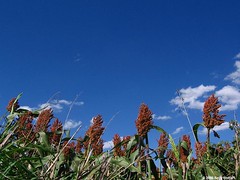Light: Quality and Quantity
Most of the time, while taking photographs, we only think in terms of whether there is enough light, how it affects our camera’s settings, and whether we will have camera shake. But just as important to getting good photos is the quality, rather than the quantity, of the light.
To understand this concept, perhaps it’s easiest to think of a sunset. When the sun is very low on the horizon, the sky around it turns red. When the sun is highest in the sky, the sky is very blue. But clearly this isn’t an instantaneous change. At times earlier or later in the day, the light is warmer (more red). Toward the middle of the day, the light is cooler (more blue). This affects your color balance in your camera, for one thing (a digital camera will usually automatically compensate, but film can’t do this, so the colors may be wrong if you shoot at the wrong time of day).
So if you’re shooting with a digital camera, you won’t have to worry too much about the color shift caused by shooting at different times of day, although it may be an issue and you may have to override your camera’s automatic white balance.
A related issue is the problem of too much light. You may not think this is possible, but it is. Imagine you are shooting in very dark light. Your picture will have very little contrast, i.e. the overall tone will be in similar shades of gray. As more light enters the scene, more contrast will show up in your pictures. During the brightest sunlight, this hits the extremes--and your camera can’t pick up the full range of tones like your eyes can. Your pictures will have areas of extreme light and dark, but the middle range will be left out. The problem is bad enough when you’re shooting in black and white, but it gets even worse in color, because the colors will also have too much contrast, and no middle range. See this shot for an example:

That’s what to avoid.
So, taking all this into account, what should you do? My recommendations:
- shoot in the hour before, and two hours after, sunrise, and the two hours before, and the hour after, sunset
- shoot on partially cloudy days
- on completely overcast days, shoot up-close subjects; you won’t cast a shadow, and the colors will be nicely saturated, so if you get the right exposure, the colors will really come out
- find shaded areas to take pictures of, like the shaded side of a building; be careful, though: if any unshaded areas get in your frame, they’ll be completely washed out
- if it’s really sunny, I’ve heard that some people will put an umbrella over their subjects (e.g. flowers)
- failing all that, try a warming filter over the lens of your camera

3 Comments:
And of course, if nothing else you can always
fix it in post-production!
Well . . . not always. Too much contrast is hard to fix, if not impossible, at least not without making the whole picture gray. I think.
I know, but it's my job to say that. I'm the photoshop geek...
By the way, I do plan on posting this week, if I get some time!
Post a Comment
<< Home